
GORDON WILLIAMSON, illustrated by IAN PALMER
KRIEGSMARINE U-BOATS 1939-45
With the opening of the U-boat campaign in US waters, and into the South Atlantic, the need for a special resupply U-boat became more and more marked. A U-boat returning from a war patrol in far-off waters would occasionally rendezvous with another whose fuel or torpedo load was running out, and would transfer whatever it could of its remaining stock before heading for its home port, an extremely difficult and hazardous task in anything but the calmest of waters. Whilst this certainly helped, the amount of supplies which could be transferred would be extremely limited.
The solution to this problem was seen to be the construction of large supply boats capable of transporting significant amounts of fuel and other essentials to those boats operating on extended patrols in distant waters. The result, designated the Type XIV, was known to the Germans as the Milchkuh, or Milk Cow. A total often such boats were constructed, six by Deutsche Werke in Kiel (U-459, U-460, U-461, U-462, U-463 and U-464) and four by Germaniawerft (U-487, 11-488, 1-489 and U-490).
Initially, these boats were highly successful and played a significant role in keeping more boats than would otherwise have been possible on station in the western and south-western Atlantic. Gradually, however, Allied intercepts of German signals, thanks to the cracking of the Enigma codes, allowed the Allies to set up ambushes in many of the designated rendezvous points, and thus, one by one, the vulnerable Milk Cows were attacked and sunk.
The first to be stink, U-464, was attacked on 21 August 1942 just seven days into her first cruise when she was attacked on the surface by a US Catalina flying boat. Although the boat was lost, her crew was rescued by an Icelandic fishing boat. U-490 was next to be lost when, also on her first cruise, she was attacked en route to the Indian Ocean by a combination of US aircraft and warships. Fortunately, all but one of her crew was rescued by her attackers. U-463 succeeded in earning out four war cruises before being attacked by a British Halifax bomber and sunk with all hands on 10 May 1943 during her fifth cruise. Whilst running on the surface to charge her batteries, U-489 was attacked by an aircraft. She was spotted by a Sunderland firing boat and, although the flying boat was shot down, the submarine was so badly damaged that it had to be abandoned. Most of the crew was rescued. Disaster struck the U-tanker programme in July 1943 when four boats, U-459, U-461, IJ-462 and U-48.7, were all attacked on the surface and sunk by Allied aircraft. Between them, however, they had carried out 21 war cruises, replenishing combat U-boats at sea. Of Germany's two remaining U-tankers, U-460 was sunk on 4 October 1943 when she was caught by enemy aircraft on the surface along with three U-boats she was refuelling. U-488 was detected whilst submerged and attacked by enemy warships west of the Cape Verde Islands on 26 April 1944 and was never seen again.
The Type XIV could carry up to 400 tons of additional fuel as well as four torpedoes, substantial amounts of fresh food, and even had its own bakery so that boats being supplied could be treated to the luxury of freshly baked bread.
SPECIFICATIONS
Length - 67.1 m
Beam - 7.3 m
Draft - 4.9 m
Displacement - 1,688 tons surfaced, 1,930 tons submerged
Speed - 14.4 knots surfaced, 6.2 knots submerged
Endurance - 9,300 nautical miles surfaced, 67 nautical miles submerged
Powerplant - 2 × 1,400 bhp diesel coupled with 2 × 375 bhp electric motors
Armament - no torpedo tubes, 2 × 3.7 cm guns, one forward and one aft of the tower, 1 × 2 cm gun on the conning tower platform.
Crew - 53
For the first half of the war, the principal armament on most U-boats was the 8.8 cm naval gun, and/or the 2 cm flak gun. As the war progressed and Allied anti-submarine measures became far more effective, U-boats tended to remain submerged wherever possible, surfacing only when safe to do so in order to run the main diesel engines to recharge their batteries. Effectively, the 8.8 cm deck gun was becoming redundant. Being little used, around April 1943 it was removed in order to save some weight and achieve a modest reduction in drag.
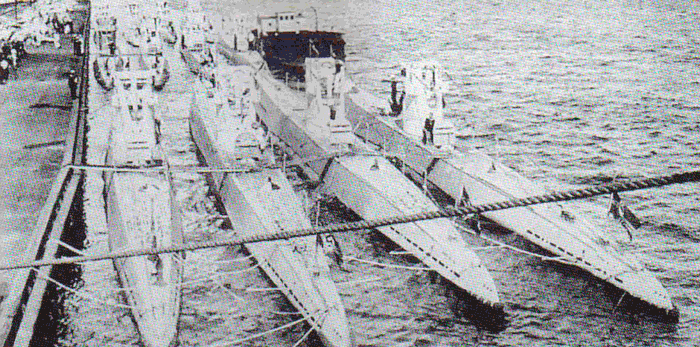
Unterseebootsflotille Weddigen at its moorings.
At the same time, the danger from air attack having increased so much, U-boat flak defences were significantly enhanced. Despite the fact that several incidents are known where U-boats successfully fought off Allied air attacks, few U-boat commanders would willingly remain on the surface to engage an aircraft in combat unless diving was impossible or unsafe.
The main deck armament therefore was only effectively used in the early part of the war, usually against lone ships or convoy stragglers in waters where there was relatively little chance of encountering enemy warships. The deck gun would have been used most often to 'finish off' a merchantman that had been damaged by torpedo, but had failed to sink. Expenditure of additional torpedoes would be considered wasteful when much cheaper and plentiful artillery shells could be used.
The 8.8 cm gun used on U-boats was not directly related to the famous 8.8 or 'Acht-Acht' flak gun which ultimately gained fame as an anti-tank weapon. More correctly entitled the 8.8 cm Schiffskanone C/35, it was a purely naval weapon, developed from earlier weapons of this type used by the Imperial German Navy in the First World War.
The gun was mounted on a low pedestal forward of the conning tower and was traversable through 360°. It could be depressed to -4° and elevated up to +30°. The gun fired a 13.7 kilo shell with a muzzle velocity of 700 metres/sec for a distance of up to 12,350 metres. When submerged, the barrel bore was protected by a waterproof tompion inserted into the muzzle.
It was crewed by three men, the kanonier (gunner), ladeschutze (loader) and richtschutze (gun-layer) supported by numerous other crewmen who would bring the ammunition up on deck from its storage under the floor plates of the Zentral. On the deck just forward and to port of the gun, was a small watertight ammunition locker giving the gun crew sufficient shells to allow the gun to be brought into action immediately whilst the bulk of the ammunition was retrieved from inside the boat. Two folding padded 'U'-shaped supports were provided on both left and right sides of the gun for the gunner and gun-layer to steady themselves against rolling or pitching of the boat. In effect, the gun would be difficult to aim successfully in anything other than calm seas. In rough seas, the crew could strap themselves into position. The gun was controlled and directed, usually by the Second Officer (II Wach Offizier or IIW.O.), from the conning tower.
Two basic designs of 2 cm flak gun (Flugabwehrkanone) were used. The earlier version, the 2 cm Flak 30, was a single-barrelled weapon, with 360° traverse and capable of -2° depression and +90° elevation. It fired a 0.32 kilo shell with a range up to 12,350 metres. Maximum cyclic rate of fire was 480 rounds per minute, but effective use was around half this rate.
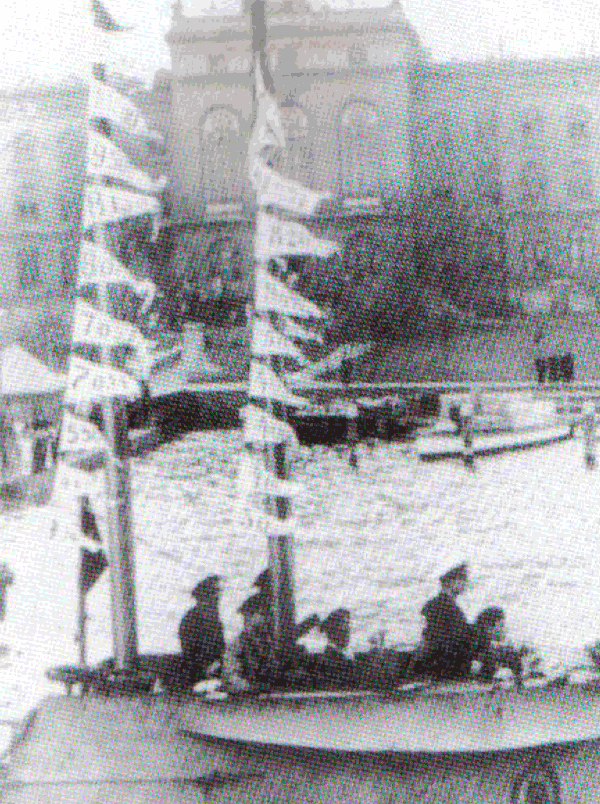
Normally, periscopes would be retracted when not actually in use. Here they have been raised to act as flagpoles for the cord from which the boat's victory pennants are strung. Each pennant has painted on it the tonnage of the vessel sunk. This photo was taken at the end of a very successful cruise for Kapitänleutnant Reinhard Hardegen and U-123, a Type VIIC.
A second, improved model, the 2 cm Flak 38, was a very similar model but had an increased rate of fire at 960 rounds per minute. The second version was also produced in twin-barrelled (Twilling) and four-barrelled (Vierling) versions. It was a direct development of a weapon designed for the army, and simply fitted to a naval pedestal mount (the lafette C/35).
In the second half of the war, many Type VIIs received the 3.7 cm Flak M/42. Also an army weapon adapted for naval use, it fired a 0.73 kilo round up to 15,350 metres at a maximum rate of fire of 50 rounds per minute.
As well as the main deck armament and flak defence weapons, a limited amount of small arms were kept on board the U-boat for use by boarding parties, guards when the boat was in dock etc. These would include the 9 mm pistol, 9 mm sub-machine gun, 9 mm machine gun and 7.92 mm rifle.
German torpedo nomenclature can be extremely confusing. There were, however, only two principal types of torpedo used on U-boats, but with several variants in detonating devices (the pistol) and in directional control. These two principal types were in fact developments of torpedoes used in the First World War, the G7a and the G7e. By the Second World War, torpedo sizes had been standardised at 54 cm (21 in.) so that all torpedoes, whether launched from surface ships or U-boats, were of the same diameter. The standard length was 7.16 m and some 280 kilos of explosive was contained in the warhead.
The G7a(TI) was a relatively simple weapon, propelled by steam from the burning of alcohol in air, supplied by a small on-board reservoir. The torpedo was driven by a single propeller. The G7a(TI) had a top speed of some 44 knots and a range of up to 6 kilometres. Its biggest drawback was its visible 'bubble' wake.
Broadly similar to the G7a model, the G7e was electrically powered, being driven by a small 100 bhp electric motor. In this case two contra-rotating propellers were fitted. The G7 series left no visible wake, and the G7e(TII) had a range of some 5 kilometres at 30 knots.

View onto the foredeck from the bridge of a Type VII, showing the 8.8 cm deck gun. The 'U'-shaped objects to the right of the gun are leather-covered bracing positions that the gun crew could lean into to steady themselves in rough seas. These could be folded away when not in use. The muzzle was sealed with a plug, whose retaining cord can be seen spiralling around the barrel.
This was a development of the G7e(TII) with greater battery capacity, allowing its effective range to increase to 7.5 kilometres.
The pistols used to detonate the torpedo were a source of great trouble to the U-Bootwaffe, with numerous failures to detonate being recorded in the early part of the war. The basic pistol was a dual-function component that could be activated by contact (Abstandzündung) or by the detection of the magnetic field generated by the hull of the ship (Magnetischerzündung).
Three principal types of directional control were developed in the Second World Wan all of which were used with some success after teething problems were eliminated.
The FaT (Flächenabsuchenden Torpedo)
The original FaT design was first used on the G7a(TI). It was an excellent anti-convoy concept in that the torpedo, instead of making a direct line to the target, ran in an 'S' configuration through the convoy until finding a target. The required launch position was alongside die convoy. A further development, the FaTII, was based on the G7e(TII).
The LuT (Lagenabhängiger Torpedo)
This torpedo, similar in concept to the FaT, allowed the U-boat to attack the convoy from any angle rather than having to attain the ideal launch position alongside the convoy.
This torpedo, based on the G7e, had acoustic detectors, which homed in on the sounds of the target vessel's propellers. It was, however, prone to premature detonation when passing through turbulent waters, such as the wake of a ship. This torpedo had a range of 5.75 kilometres at 24.5 knots.
This was a development of the basic Zaunkdnig, which had the acoustic detectors tuned to specific frequencies of ship's propellers to avoid premature detonation, and was to be used with some success as an anti-escort weapon, fired from the stern torpedo tube against pursuing escort vessels.
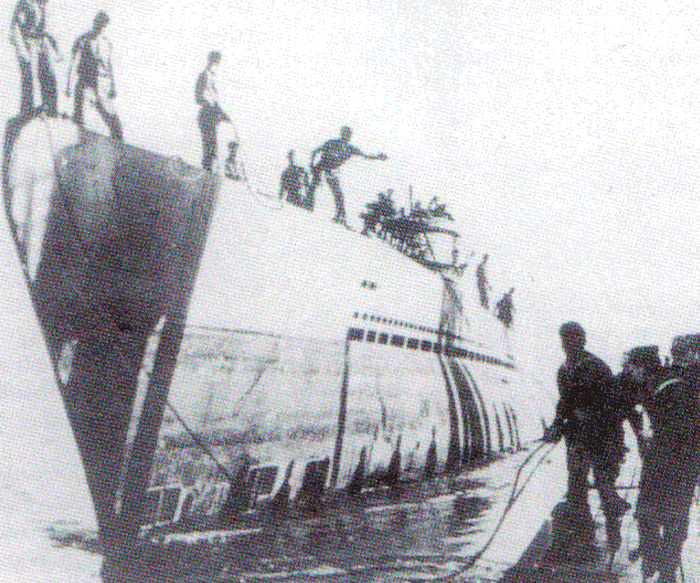
U-462, a Type XIV tanker, returns to port after a mission. Her fuel bunkers depleted, she sits high in the water showing the huge bulk of her hull.
There were a number of developments in submarine-1aunched mines during the Second World War, of which the four most significant were the TMA, TMB, TMG and SMA.
This mine was for use in depths of up to 270 metres and carried an explosive charge of some 215 kilos. Launched through the torpedo tube, it was of the same diameter as the standard torpedo, but shorter at 3.4 metres, so that two could be launched from each tube at the same time.
Designed for use in shallow waters of up to just 20 metres, the TMB was shorter again, at just 2.3 metres, but carried a 580-kilo charge. Three could be carried in and launched from each tube.
This was a development of the TMB, larger at 3.3 metres in length, but with a 1,000-kilo charge. Two could be carried in and launched from each tube.
This mine was designed for dropping from a vertical mine shaft in specially designed mine laying boats rather than launching from the torpedo tubes. It was 2.15 metres in length and carried a 350-kilo charge. It could be used in waters up to 250 metres in depth.
All of the U-boat types covered in this volume were diesel powered, with additional electric motors coupled onto the same propeller shafts as the diesels. Diesels were used for surface running, and electric motors for running submerged.
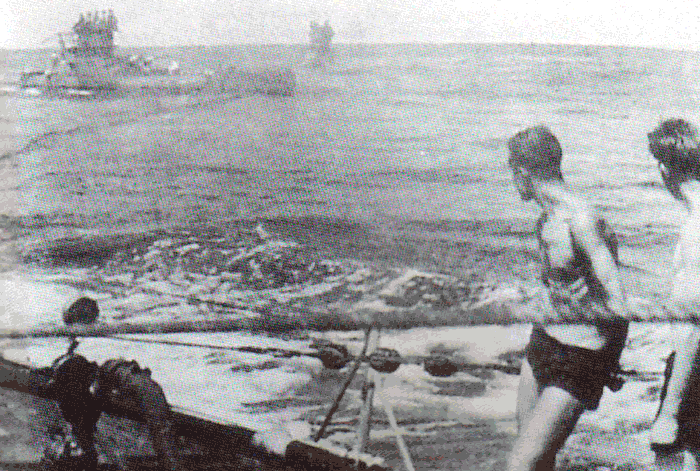
Crewmen on board U-461, a Type XIV, observe as mid-ocean refuelling begins. One submarine is being refuelled whilst another waits its turn. The fuel pipe and valves can be seen to the left of centre.
Not until the advent of the snorkel was it possible for a U-boat to charge its electric motors by running its diesels whilst still at periscope depth. The snorkel was a simple 'breathing' tube that allowed air to be drawn into the boat whilst submerged. Its head contained a simple flap mechanism with a flotation ball. The rise of a wave against the head would lift the ball, sealing the tube and preventing the ingress of water. The main problem with the snorkel arose when the boat's depth was not correctly monitored and it slipped below periscope depth, or in heavy seas when the flap remained closed more often than open. When no air was being taken into the boat, the engines would draw their air from the boat's interior, creating a partial vacuum and debilitating the crew.
The diesel engines driving each propeller shaft were mounted on extremely robust foundations. Almost completely filling the engine room space, only a narrow access passage between the two allowed movement through the compartment. Serving in the confines of the engine room was hot, smelly and unpleasant. Many mechanical breakdowns were extremely difficult to work on due to the cramped space.
The Type VIIA was outfitted with two six-cylinder Maschinenfabrik Augsburg-Nürnberg (MAN) or Germaniawerft diesels, each developing 1,160 bhp. Coupled onto the same shafts were two 375 hp electric motors that, when the clutch was disengaged and they were rotating freely whilst the diesels drove the boat, acted as generators to recharge the batteries. Principal suppliers of electric motors for U-boats were Siemens, AEG and Brown-Boveri. Later Type Mis (B-F) used two 1,400 bhp diesels paired with two 375 bhp electric motors.
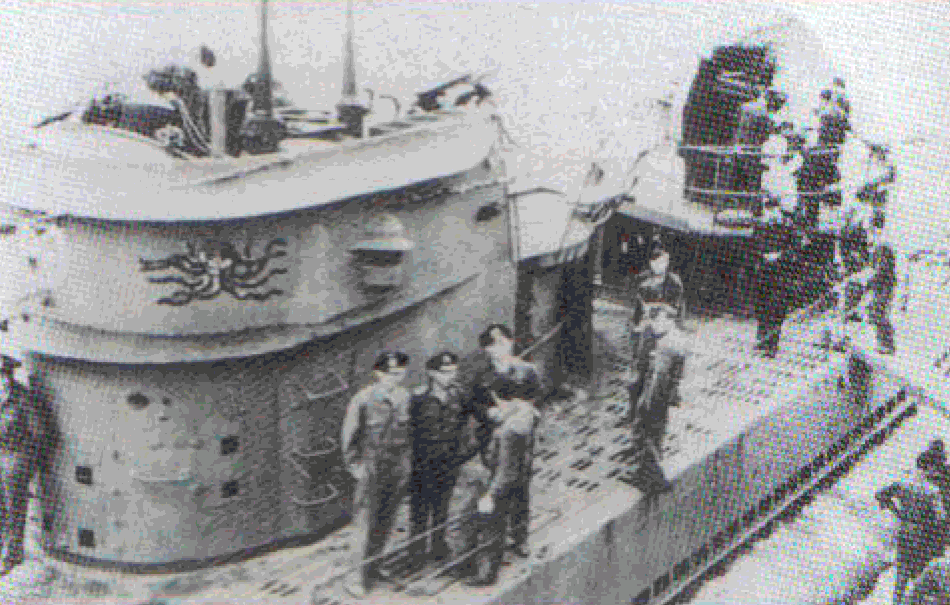
U-462, a Type XIV, displays an unusual flak set-up. A Flakvierting has been mounted on a separate pedestal platform separated from the main tower. Note the boat's Octopus emblem.
We have much more interesting information on this site.
Click MENU to check it out!
∎ cartalana.com© 2009-2025 ∎ mailto: cartalana@cartalana.com